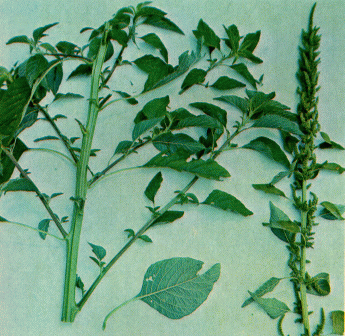
Known as: Amaranth, Callalo, Pigweed
Latin Name: Amaranthus family
Description: Erect stems up to 6 feet high with rough texture
and freely branching off the main stem. Dull green leaves, long petioles.
Small, green flowers in dense spikes in upper leaf axils and stem ends,
with three spiny bracts around each flower. Density of flower heads will
vary according to family member. Shiny black, tiny seed. Although
cats are unlikely to be outside eating pigweed, some members of the Amaranthus
family are used in dried flower arrangements which your cat could play
with or find and eat seeds.
Poisonous Parts: Leaves, stems, roots. Toxins involved
are nephrotoxin, soluble oxalates and nitrates. Toxicity can be due to
any combination of these toxicoses.
Symptoms: Produces varied toxic effects. Most common signs:
Breathing problems, trembling, weakness, abortions, coma, death.
Can also cause kidney failure. Onset of signs may be
as much as 3 to 7 days from the time of ingestion. In affected animals,
early signs include weakness, trembling and incoordination. This progresses
to an inability to stand and paralysis, yet the animals may still be alert
and able to eat. Near the end of the clinical course, the affected animals
may go into a coma, and have edema under the skin of the abdomen and the
legs, have a bloated abdomen, and die. The course of the disease is approximately
48 hours and is primarily consistent with kidney failure.
Treatment: Contact your vet or nearest emergency clinic immediately.
